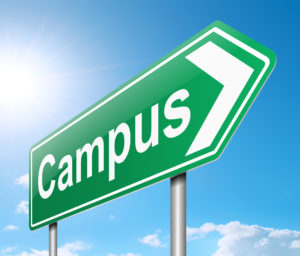Though the word “campus” often evokes an image of brick buildings in the middle of trees, sidewalks and busy students, the campus of tomorrow won’t look quite the same.
Instead, a new report outlines a different reality brought on by the move to digital resources and on-demand learning. Much attention has been paid to how pedagogy and management are changing, but less attention is focused on the physical dimension.
“Innovations in physical space must be made to accommodate demands for accessibility, flexibility and affordability,” according to The State of Higher Education in 2017, a report from professional services firm Grant Thornton.
The report notes that while college and university leaders have new opportunities when it comes to technology and analytical tools that enable new management strategies and learning initiatives. But those same leaders also deal with challenges, such as competition from nontraditional education providers and making effective use of physical assets.
(Next page: Today’s changes will bring about tomorrow’s campus)
Changes in infrastructure are being driven by a handful of trends, including:
- Digital technology is decoupling access to the classroom and information from any specific geographic location.
- Learning is becoming more “modular,” credentialing specific competencies, such as certificates and badges,, rather than the model of four years to a degree via fixed-class schedules. This requires a less broad range of academic buildings on campus.
- Students will engage with their coursework at their own time and pace, as they do in every other aspect of their lives.
- Price pressure on colleges will create incentives for cost efficiencies, discouraging the fixed-cost commitment embodied in physical structures.
- Deferred maintenance is a problem so large that it can’t be solved by most colleges within their available resources; the result may be reducing the physical plant footprint or just letting it deteriorate further.
These developments will prompt physical space transformation that will lead to a new kind of campus.
Classrooms will be housed on digital devices: Technology has changed the need for individuals to gather in a physical space to engage with each other on important topoics. This is how much of our learning will be conducted. In some cases, only some classes will be virtual, while in others, all classes will move in that direction.
Services will largely be outsourced, including to the cloud: The need for office and physical service desk space will be radically reduced. Libraries will focus on making digital connections between researchers and information sources.
Physical spsace will be available primarily for occastional face-to-face purposes: Facilities might be used in a multipurpose way for either classroom activities or administrative meetings. There may well be little space “owned” by the college–instead, it will be leased to flex with needs as they arise.
The size and number of physical campuses will shrink, as will their related costs: The need to reduce costs will be a key driver, because many colleges will not be able to raise revenue sufficient to subsidize current amounts of square feet.
Access to education and information will expand and prestigious institutions will domate when no longer constrained by physical limitations: Students will be able to obtain instruction and conduct research from any location.
The report also offers a look at higher education in 2050.
Virtual connections are ubiquitous
Universities operate in a connected world with information available, and coursework possible, 24/7. Instructors interact on screen from any country, and teaching and student evaluations happen at a much faster pace than in earlier decades. Online classes are the norm, and teaching assistant droids address online questions. Students can take courses around the clock to accommodate their schedules and academic interests. Some courses are still face-to-face, video streamed from other schools.
Brick and mortar still has uses
A campus is a set of compact buildings, with research and lab space available 24/7. Libraries are no longer repositories for books. Instead, they are collections of collaboration rooms and workstations. Librarians are technology specialists who guide access to information, troubleshoot video and hologram conferencing programs, solve connectivity issues, help with 3D printers, etc.
Affordability and applicability remain key to college choice
Enhanced access to information around tuition costs, majors, and job and salary prospects helps make higher-ed decisions much easier. Students can trade research time for tuition, and nonprofit and for-profit companies reimburse universities for students’ research results. Students receive class credit for major-related jobs, volunteer work and internships. Collegiate video gaming is big as well, and leagues are international.
- Report forecasts a ‘surge’ in GenAI adoption - April 26, 2024
- Where are microcredentials today–and where are they going? - April 22, 2024
- First-generation students are more likely to seriously consider leaving college - April 17, 2024

